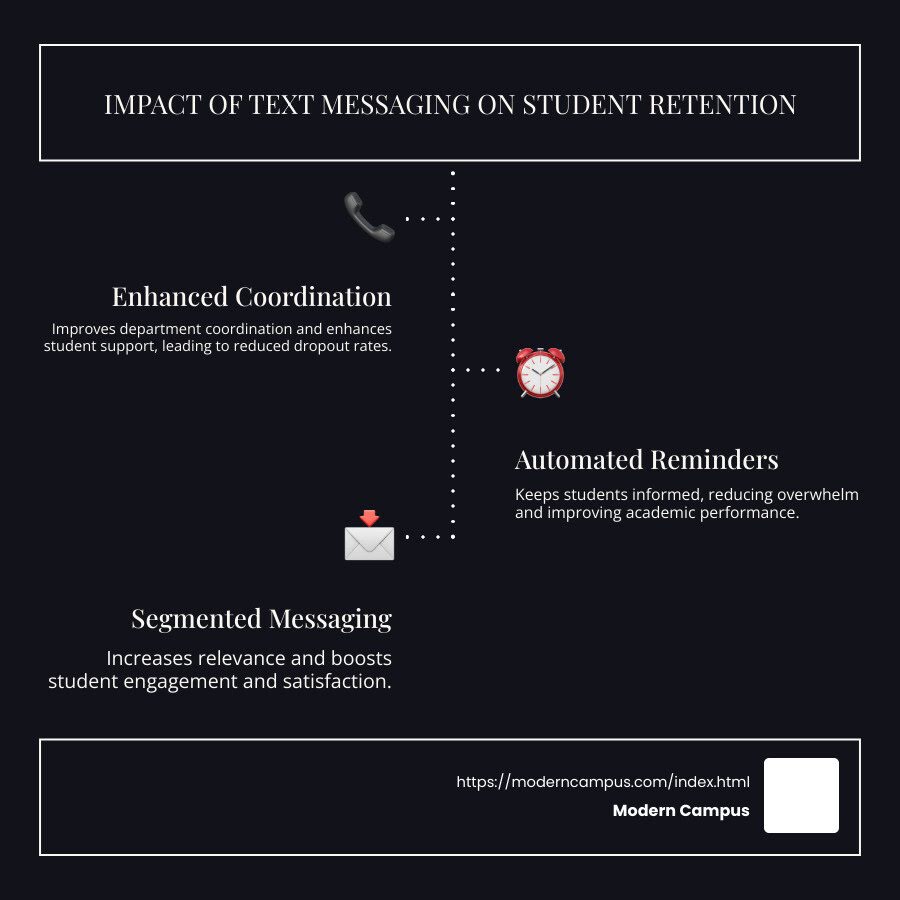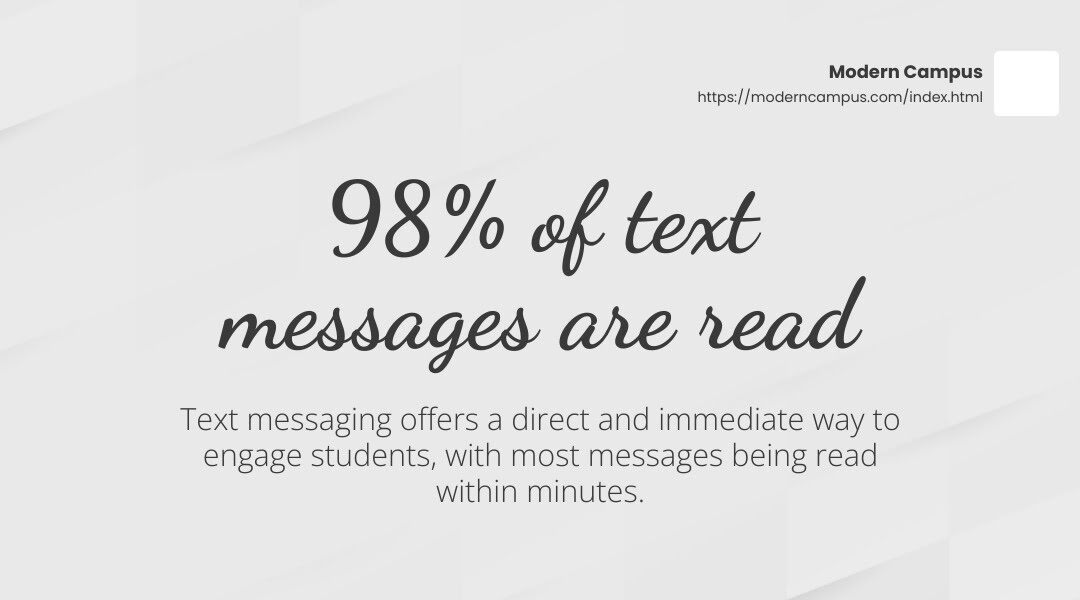Higher Ed Retention: Text Messaging Strategies That Work
Student retention is one of the biggest challenges facing higher education institutions. With increasing academic pressures, financial constraints and feelings of disconnection, many students struggle to stay on track and complete their degrees. While colleges and universities invest heavily in support services, reaching students at the right time with the right message remains a critical hurdle.
Unlike emails that go unread or phone calls that feel intrusive, text messaging is a direct and effective way to engage students in real time. From deadline reminders to personalized support, this simple yet powerful tool can bridge the communication gap and provide students with the guidance they need—exactly when they need it.
It’s important to explore the relationship between higher ed retention and text messaging to uncover strategies that institutions can use to improve student engagement, enhance support and ultimately keep more students enrolled.

The Link Between Higher Ed Retention and Text Messaging
Student retention is directly tied to how well institutions communicate with and support their students throughout their academic journey. By leveraging text messaging, colleges and universities can provide timely, personalized outreach that keeps students engaged, informed and more likely to persist through graduation.
Why Student Retention Is a Pressing Issue in Higher Education
Many students face challenges that can lead to dropout, such as financial difficulties, academic struggles and a lack of engagement. Retention rates are indicators of an institution's success and reputation. When students leave, it affects not only their future but also the institution's funding and standing.
One of the main challenges is engaging students. Traditional communication methods like email often fail to capture students' attention. With emails averaging a mere 20% open rate, many important messages go unnoticed. This lack of engagement can lead to missed deadlines, unmet academic requirements and student withdrawal.
The Power of Text Messaging: Meeting Students Where They Are
Text messaging is a game-changer for higher ed retention. It leverages the fact that 98% of text messages are read, often within minutes of receipt. Immediacy and directness make texting an ideal tool for effectively reaching students.

With 91% of American adults owning a smartphone, texting meets students where they are—on their devices. Unlike emails that can get buried in crowded inboxes, texts cut through the noise, ensuring crucial information reaches students quickly. Direct communication is essential for keeping students informed and engaged, helping them stay on track with their academic journey.
How Personalized, Automated Messages Can Improve Student Engagement
Personalization is key to effective communication. Institutions can make their messages more relevant and engaging by using students' names, referencing their majors or sending reminders specific to their academic status. Automated messaging systems make personalization at scale possible. These messages help students feel valued and supported, increasing their likelihood of staying enrolled. By addressing individual needs and preferences, institutions can foster a sense of belonging and improve overall student satisfaction.
Higher ed retention and text messaging are intertwined. By addressing the pressing issue of student retention with powerful, personalized text messaging strategies, institutions can significantly improve student engagement and success.
Best Practices for Using Text Messaging to Boost Retention
Effective text messaging creates meaningful touchpoints that support students academically, socially and emotionally. Implementing strategic messaging practices allows institutions to foster engagement, provide proactive assistance and improve student retention rates.
Timely Academic Reminders: Keeping Students on Track
Text messages are perfect for sending timely academic reminders. Whether it's about registration deadlines, exam schedules or assignment due dates, a quick text can keep students on track.
A simple, personalized reminder like, "Hey Alex, don't forget your math assignment is due tomorrow at 5 PM!" can make all the difference in a student's day. Personalization transforms a generic reminder into a supportive nudge.
Engaging New Students: Orientation, Resources and Support
Starting college can be overwhelming, but texting can ease this transition for new students. Use texts to share information about orientation sessions, campus resources and support services.
For instance, a message like, "Welcome, Sarah! Don’t miss the orientation event tomorrow at 10 AM. Meet fellow freshmen and explore campus resources. See you there!" can help new students feel welcomed and informed.
Personalized Advising: Proactive Outreach to At-Risk Students
Proactive advising through text messaging can be a lifeline for at-risk students. By identifying students who might be struggling, institutions can send personalized messages offering support and advice.
For example, a message like, "Hi Chris, we noticed you missed the last advising session. We're here to help! Schedule a meeting with your advisor today." Such messages show students that the institution cares and is ready to support them.
Fostering a Sense of Belonging Through Campus Life Notifications
A sense of belonging is vital for student retention. Text messaging can help by notifying students about campus events, clubs and activities. Notifications encourage students to participate and connect with their peers, which improves their college experience.
A text like, "Join us for the campus movie night this Friday at 7 PM! Bring a friend and enjoy some popcorn!" can foster community and engagement. By keeping students informed about campus life, institutions can help them feel more connected and invested in their college experience.
Higher ed retention and text messaging go hand in hand. Implementing these best practices, can improve an institution’s student engagement and ensure students feel supported throughout their academic journey.
Overcoming Common Barriers to Text Messaging in Higher Ed
While text messaging is a powerful tool for student engagement, several barriers can hinder its effectiveness. Let’s explore how to overcome these challenges.
Compliance and Privacy Considerations
When using text messaging in higher education, privacy and compliance are top priorities. Institutions must adhere to regulations like the Telephone Consumer Protection Act (TCPA), which mandates obtaining proper consent before sending messages. Students should opt-in to receive texts, ensuring they are willing participants.
Avoiding Message Fatigue: Striking the Right Balance
Message fatigue occurs when students receive too many texts, leading them to ignore or opt out of future communications. To prevent this, strike the balance between frequency and content.
Focus on sending meaningful and necessary messages. For instance, limit texts to essential reminders, urgent updates or personalized support. Use student feedback to refine your messaging strategy. A simple survey can reveal how often students prefer to receive texts and what information they find most valuable.
Integrating Messaging With Existing Student Support Systems
To maximize the impact of text messaging, integrate it with existing student support systems. This ensures a seamless flow of communication and support across different platforms.
For example, digital messaging platforms can sync with student information systems (SIS) to automate personalized messages based on student data, like academic performance or attendance. Integration allows for targeted outreach, ensuring that students receive relevant support when they need it most.
By overcoming these barriers, institutions can leverage text messaging to improve student engagement and retention.
Measuring Success: How to Track the Impact of Text Messaging on Retention
Tracking the success of text messaging in higher education helps institutions understand its impact on student retention. Let's explore the key metrics to monitor and real-world examples of universities seeing retention gains.
Key Metrics to Monitor Student Engagement
To effectively measure the impact of text messaging on student engagement, institutions should focus on several key metrics:
- Response Rate: This metric indicates how many students are actively engaging with the messages. A high response rate suggests that the content is relevant and timely.
- Opt-Out Rate: Monitoring the opt-out rate helps identify if students are experiencing message fatigue. A low opt-out rate is a positive sign that the messaging frequency and content are well-balanced.
- Appointment Scheduling: Track the number of students who schedule appointments with advisors or attend events after receiving a text message reminder. This shows how effectively messages prompt action.
- Retention Rates: The goal is to improve retention. Compare retention rates before and after implementing text messaging campaigns to assess their effectiveness.
- Feedback and Satisfaction: Use surveys or feedback forms to gather student opinions on the messaging system. Qualitative data can provide insights into areas for improvement.
By analyzing these metrics, institutions can refine their text messaging strategies to improve student retention.
Real-World Examples of Institutions Seeing Retention Gains
Institutions across the globe have successfully used text messaging to boost student retention. Here are a couple of inspiring examples:
- Hartford Community College: This college found that students who received text reminders about campus events were 53.7% more likely to persist to the next academic year. By sending targeted messages, they increased student participation and engagement in co-curricular activities, which are linked to higher retention rates.
- Arkansas Tech University: First-year students who engaged in community service and received supportive text messages had a remarkable 94% retention rate. This was 22 percentage points higher than peers who did not receive such messages. The university's proactive communication strategy helped students feel connected and supported, reducing dropout rates.
These examples illustrate the power of text messaging in fostering a sense of belonging and encouraging student engagement, ultimately improving retention rates.
Strengthen Student Success With the Right Text Messaging Strategy
Student retention is a challenge that requires intentional and proactive communication. Text messaging is a powerful tool to keep students engaged by providing timely academic reminders, personalized advising and a sense of connection to campus life. By integrating thoughtful messaging strategies, institutions can address common retention barriers, ensuring students receive the support they need to stay on track and succeed.
Modern Campus helps institutions leverage text messaging to drive higher ed retention through automated, personalized and scalable communication. With tools designed to engage students at critical moments—whether it’s deadline alerts, proactive intervention for at-risk students or fostering a sense of belonging—Modern Campus empowers institutions to enhance student success. Request a demo today to learn how Modern Campus can help you keep more students engaged and on the path to graduation.
Last updated: April 9, 2025

